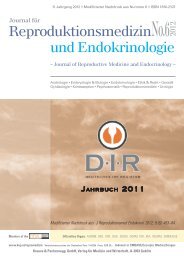Die Freiheit, nicht immer daran denken zu müssen. myome ...
Die Freiheit, nicht immer daran denken zu müssen. myome ...
Die Freiheit, nicht immer daran denken zu müssen. myome ...
Erfolgreiche ePaper selbst erstellen
Machen Sie aus Ihren PDF Publikationen ein blätterbares Flipbook mit unserer einzigartigen Google optimierten e-Paper Software.
Broad indications for PGS by polar body biopsy<br />
P14<br />
Acar B.,<br />
Weimer J.,<br />
Salmassi A.,<br />
Mettler L.,<br />
Jonat W.,<br />
Arnold N.,<br />
Schmutzler A.G.<br />
University Woman’s Hospital,<br />
Christian-Albrechts-Universität,<br />
Kiel<br />
Introduction:<br />
The primary aim of preimplantation genetic screening (PGS) is to improve<br />
success rates in ART. Previously in preclinical trials we found out, unfertilized<br />
oocytes had high aneuploidy rate also in young women. As we now<br />
got comparable success rates with PGS, we retrospectively analysed the<br />
embryology and clinics of our success cascade in order to fi nd hints for a<br />
change of management and wanted to know, how the number of oocytes<br />
infl uences the success in PGS.<br />
Material and Methods:<br />
After approval by the local ethics committee we started a series of 100 cycles<br />
in our IVF unit. In 2004 and 2005 we performed 60 cycles, to all patients<br />
with 6 or more oocytes. PGS was performed by laser biopsy of the fi rst polar<br />
body on day 0, fi xation for FISH and hybridization with chromosome 13,<br />
16, 18, 21, 22 (Vysis). Zygote selection was done on day 1 in accordance<br />
with the German embryo protection law, embryo transfer usually on day<br />
two, intended to have two embryos, generated from proven “euploid” (for 5<br />
chromosomes) oocytes. If there were not two euploid oocytes available, one<br />
or two biopsied, but not detected oocytes were transferred.<br />
Results:<br />
The average age of the women was 36 years (range 25-44 years). ET was<br />
performed in 57 cases (95 %), resulting in 14 (25 %) pregnancies, 5 deliveries<br />
(once twins), 4 abortions (29 %), 5 ongoing pregnancies. 642 oocytes<br />
were retrieved, of these 584 (91 %) were mature, 498 (85 %) were biopsied<br />
(the rest was not biopsied and frozen when fertilized). 454 (91 %) survived,<br />
365/498 (73 %) fertilized. 449/498 (90 %) could be fi xed, 334 of these<br />
(74 %) got a genetic result, 129 of these (34 %) were euploid. 106 embryos<br />
(1,9 per transfer) were transferred, 66 of these (62 %) were generated from<br />
euploid oocytes. The implantation rate was 14 % (15/106). In 25 from 60<br />
cycles the intended “good” ET from 2 proven euploid oocytes was done<br />
(42 %). If there were “fewer” (6-7) oocytes, 3/23 (13 %) got a good ET, if<br />
there were “more” (8 or more) oocytes, 22/37 (59 %) got a good ET, this<br />
difference is highly signifi cant (p< 0,001).<br />
Conclusions:<br />
Pregnancy and implantation rates (25 % and 14 %) were comparable with<br />
the German national averages (28 % and 16 %). The rate of embryo transfer<br />
(1,9) was lower than the German average (2,2). Improvements of the used<br />
technique, changing the genetic technique by analysing also the second<br />
polar body, more chromosomes by FISH, or all by CGH and requirement of<br />
a minimum 8 oocytes are the possible improvements in PGS.<br />
IVF-JUBILÄUMSTREFFEN, KIEL 23. - 25. NOVEMBER 2006<br />
49










